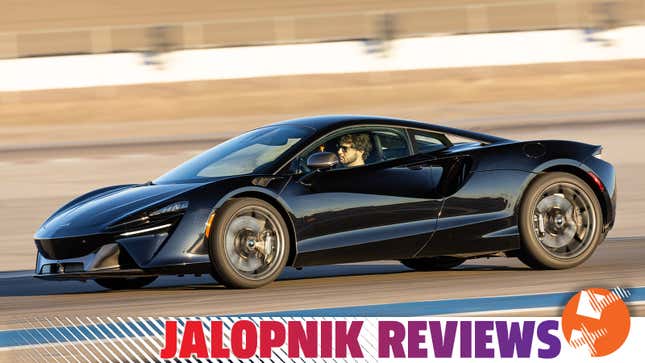
Sometimes when an automaker introduces a new vehicle, the word “new” does some seriously heavy lifting. In spite of its recognizable exterior, the McLaren Artura is about as fresh as a car can be. I’d wager the dichotomy of the familiar styling and all the advancement it conceals isn’t coincidental.
While the Artura is far from McLaren’s first hybrid — that’d be the P1 — it is the brand’s first hybrid designed for series production. It’s also the Woking-based manufacturer’s first modern vehicle without the familiar twin-turbo V8 that traces its inception back to Nissan’s late-’90s GT racing program. The Artura heralds so many changes, even its very moniker marks a new precedent. Real names with vowels were previously only given to the company’s most exclusive, Ultimate-series creations.
Had I known none of this, I’d probably glance at the Artura and chalk it up as another refinement of the same formula that’s guided every McLaren from the MP4-12C to the 765LT. I was actually a little worried about that when we got our first peek at the supercar’s silhouette two years ago. Having now driven it, I find the familiarity comforting — a reminder that, while plenty has changed, McLaren hasn’t lost the plot.
Full disclosure: McLaren flew me to Las Vegas, put me up at the Wynn for two nights and treated me to some very nice meals before giving me the keys to an orange Artura to cruise around lower Nevada. Between you and me, that would’ve been enough, but then I got to run a bunch of laps at Las Vegas Motor Speedway’s infield course.
2023 McLaren Artura: What Is It?
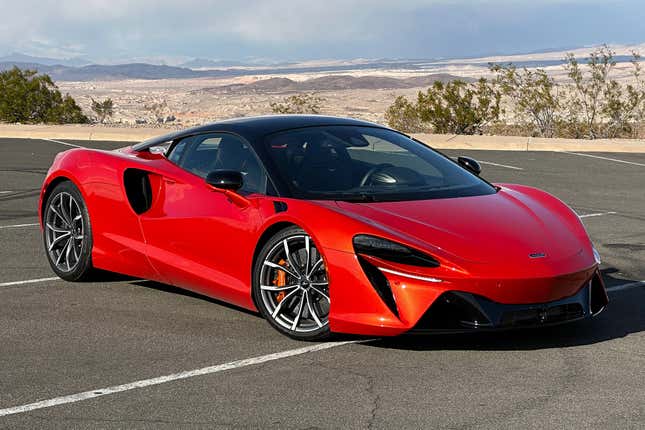
Some have pegged the Artura as McLaren’s replacement for the 570S and its derivatives that comprised the automaker’s lower-rung “Sports Series.” That’s not an incorrect way of looking at it; the 570S has been discontinued, after all. But the 671-horsepower Artura starts at $237,500, about $46,000 higher than the 570S. That slots it between the $213,000 GT and the $299,000 720S.
In other words, while the Artura is technically the entry-level performance-focused McLaren, the price to poke your foot in the door has gone up. McLaren also prefers to think of the Artura as more supercar than sports car, as if the 570S wasn’t plenty super already. (Relegating the 570S to “sports car” always felt a little absurd when it did 0-60 MPH in 3.2 seconds.)
In creating McLaren’s first bread-and-butter hybrid, the engineering team’s priority was to mitigate the disadvantages of the electric drive system (read: weight) as much as possible. “We were really fighting for every millimeter,” Chief Engineer Geoff Grose told me. That led to a peculiar engine choice and some pretty ingenious packaging.
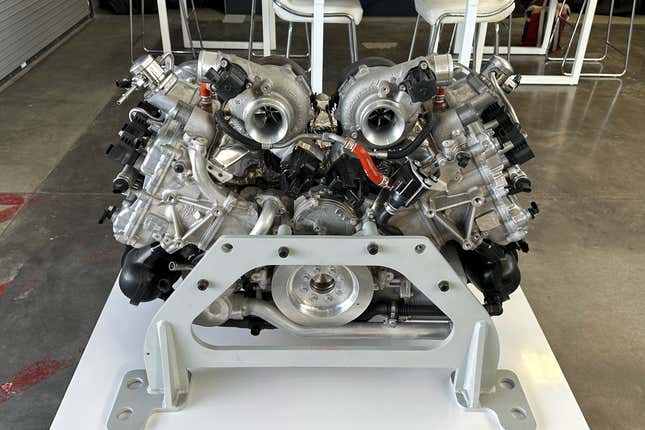
McLaren and Ferrari each have a hand on the first-place trophy for bringing a 120-degree V6 to market. (The vast majority of V6 engines are 60- or 90-degree designs.) In McLaren’s case, the 3.0-liter, twin-turbo M630 is 110 pounds lighter than the old V8. The crank is shorter and therefore stronger, by virtue of lopping two cylinders off and devoting one crank pin to every pair of opposing cylinders. The turbochargers are nestled “hot-vee” style in the valley of the bank, while there’s just enough room under the cylinder heads to slot in the intake manifolds. Output is rated at 577 hp and 431 lb-ft of torque.
The flattened-out engine keeps the center of gravity low, and the result looks like a brick — with no sprawl, no empty space anywhere. And even considering the 120-degree shape, the new V6 still manages to measure 8.6 inches narrower than the old V8.
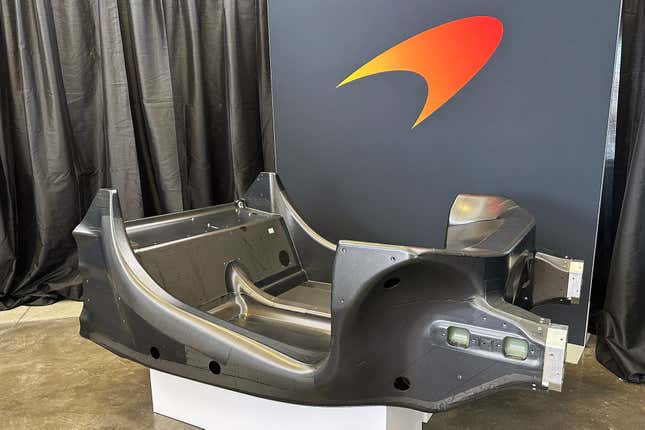
That engine sits behind the company’s new McLaren Carbon Lightweight Architecture monocell, manufactured in a new facility in Northern England. The MCLA tub weighs just 175 pounds, and is built in merely an hour by infusing preformed carbon-fiber panels with resin and clamping everything together with phenomenal force through a process called resin transfer molding.
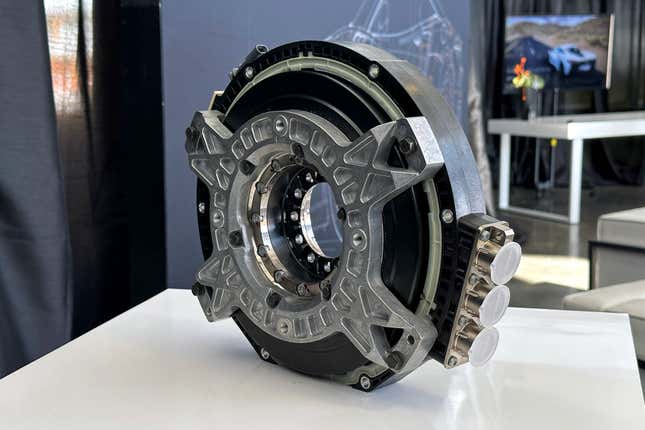
The axial-flux electric motor looks like an extra-beefy brake disc and mounts within the bell housing of the gearbox, contributing 94 hp and 166 lb-ft of torque. It weighs just 34 pounds — less than half as heavy as the P1’s motor, even though it’s a third more power-dense. Because of it, the Artura’s eight-speed transmission can save the added length of a reverse gear; the electric motor simply runs backwards when you shift into R.
The end result of so many little efficiency decisions is a car that, at 3,303 pounds, weighs roughly 100 pounds more than the 570S — yet with about 110 more horsepower and 90 more lb-ft of torque. Even those numbers fail to communicate the full story, because the bulk of the torque comes early in the rev range, and wouldn’t be there if not for the electric motor. The sprint to 60 MPH is dispensed in three seconds flat by McLaren’s estimation, and the Artura will reach 124 MPH in 8.3 seconds.
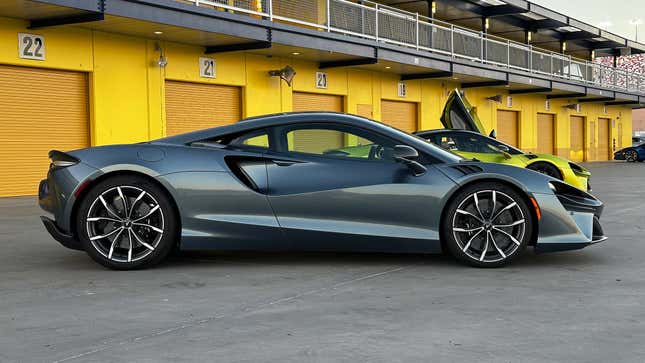
Not that you’d suspect any of this from the outside, though, because McLaren didn’t take any design risks with the Artura. At a time when even Formula 1 cars are getting long and heavy, it was very important to McLaren’s design team that the Artura’s wheelbase and overall proportions remain consistent with the archetypal supercar and its predecessors.
They nailed it in my view; this car looks stunning yet simple in profile. I adore the deep, dramatic side intakes; the flying B-pillars; and the center-exit exhaust set within the rear mesh. My favorite exterior detail is actually the little bump in the roofline, above the rear window but before the arching pillars. It’s not visible from all angles or in every lighting condition, but it’s an added detail that really balances the top of the car with those rear haunches, if you happen to catch it.
2023 McLaren Artura: How Does It Drive?
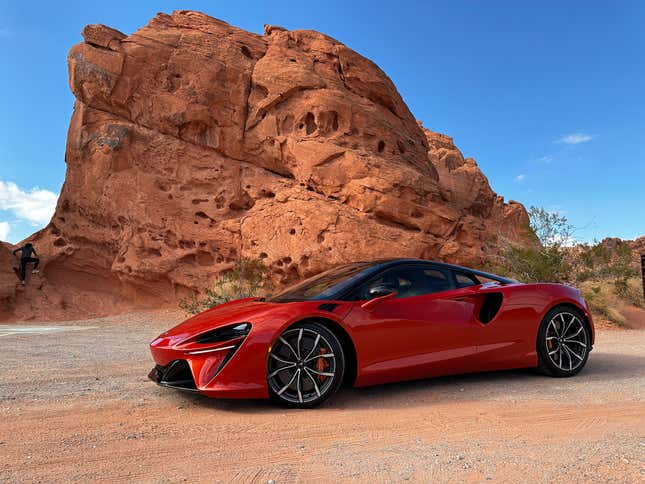
No sense dancing around it: This was my first opportunity behind the wheel of any McLaren. I didn’t have specific expectations, though on some unconscious level I suspected the Artura might be quirkier or more complicated to drive than it is.
Turns out, nope — everything pretty much comes naturally. McLaren opted for electrohydraulic steering and conventional mechanical brakes in the Artura, eschewing the electric-assist or drive-by-wire systems that have become commonplace. You lose some customizability in steering feel, but of course gain response and precision in spades.
The philosophy toward steering assistance actually reveals a lot about this car. A very patient McLaren engineer could sit me down and spend hours explaining all of the Artura’s cutting-edge tech to me, and by the end of our chat I’d still be wearing the same dumb look on my face that disappointed generations of New Jersey’s finest math teachers. When you’re driving it, though, all that complexity is obscured to you. The result is a supercar that feels less fussy than most of the $40,000 hot hatches I’ve sampled recently.
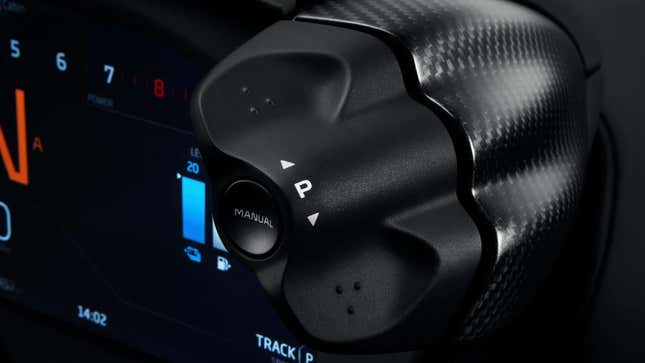
Here’s an example: There are two toggles for driving modes, which seems like at least one too many at first blush. Those are the “alien hand pods” we’ve talked about before, mounted to each side of the instrument binnacle. The one on the left adjusts your adaptive dampers, while the one on the right tends to the powertrain, modulating the interplay between the electric motor and internal-combustion engine, and mapping the battery’s charging regimen.
McLaren could’ve packaged every permutation of handling and power settings together, then concealed them behind a button that never really let on what changes were being made. Instead, as is McLaren tradition, you get discrete switches for each and you know exactly what they do, making it effortless to tweak the car to your exact desires.
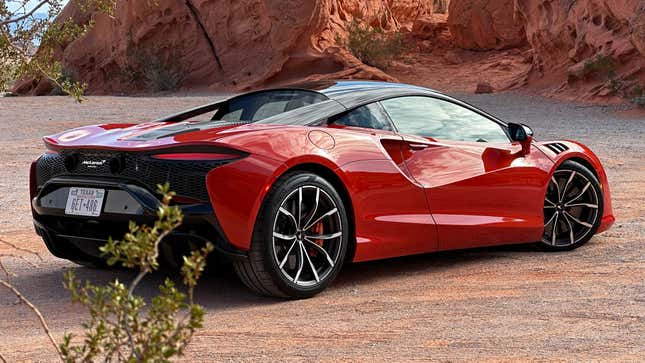
The Artura always starts in electric-only mode. This sort of takes you by surprise at first, because you’re expecting the V6 to pipe up. The EPA estimates an all-electric driving range of just 11 miles for the Artura, though McLaren personnel indicated they’ve gotten up to 19 miles in their own driving, back home in the U.K.
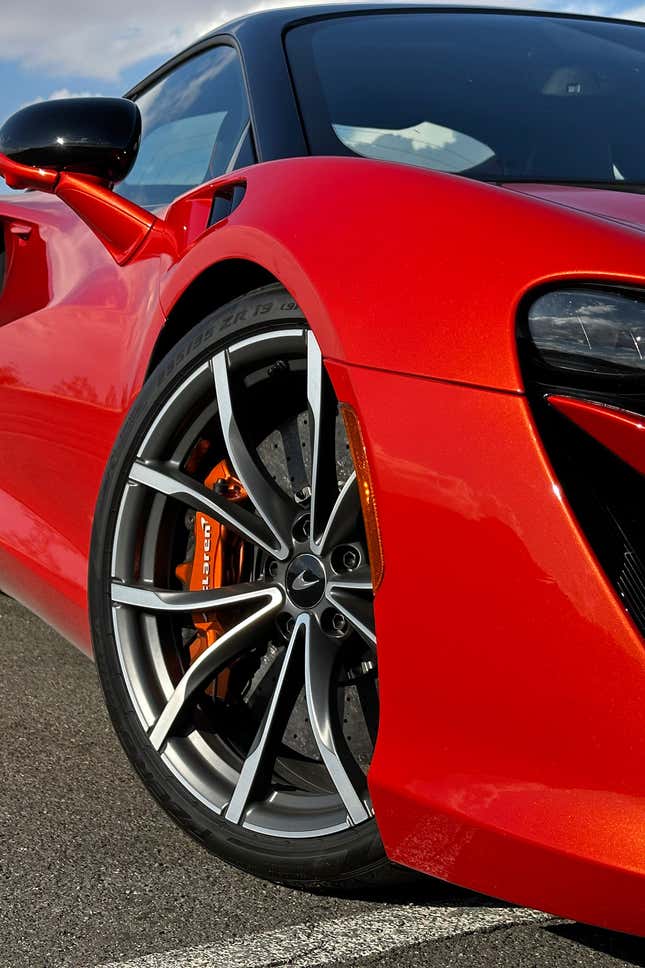
The insistence on starting in EV mode makes sense, however, if you consider two things. First, like any other plug-in hybrid, the Artura is ideal for emissions-free short trips, and McLaren wants owners to use it as such. Second, while the electric motor gets you out of the driveway and down the road, the internal-combustion engine gets a generous 45 seconds to warm up and condition itself for duty. When the engine does kick in, above 40 MPH in Comfort Mode, it does so seamlessly.
At one point during my drive through the desert, I stopped for about 20 minutes to snap some photos by the Seven Sisters in the Valley of Fire State Park. When I got back in the car, I decided to cruise for a bit in pure-electric mode, even though the battery showed just one mile of juice remaining. That one mile lasted for maybe two or three, and when the battery finally did give out, the V6 took over smoothly. The car didn’t even boot me out of Electric mode and into Comfort, even though it was now burning gas.
Toggling up to Sport or Track leaves the ICE running as long as the car is moving, and prioritizes more aggressive battery regeneration. The Artura is unusual among PHEVs in that it doesn’t offer any form of regenerative braking; all charging is handled by the engine, or by plugging in. McLaren wanted consistent brake feel, without the sometimes-clunky handoff between regen and friction braking. The brake pedal does indeed feel firm, with very short travel to maximum power. It’s useful for the track, but dare I say a little over-sensitive for daily driving. Likewise, in automatic mode, the downshifts while approaching stop signs can roll in a tinge jerky.

Speaking of the track, if you’ve come for an account of what the Artura is like to drive at the absolute limit, I’m afraid to say you’re not going to get that from me. What I can say is that it had more grip than I could fathom, particularly as I laid down the power and unwound the steering wheel exiting the long, almost semi-circular Turn 2 at Las Vegas Motor Speedway’s infield road course. No matter your skill level, driving the Artura at pace is fun, and also proof of how drastically those aforementioned driving profiles transform the car’s flavor. Power delivery felt telepathic in full Track mode, and kept the Artura even flatter and more rigid in mid-speed corners than in Sport.
2023 McLaren Artura: How’s the Interior?

You may get the impression of the Artura as an “everyday supercar” reading all this, and that’s a pretty fair assessment. The ride in Comfort mode felt reasonably compliant even on choppier desert pavement, and nothing about the car is intimidating. Even visibility from the driver’s seat is better than I’ve found in many compacts and crossovers that cost a fraction of the sum.
That sentiment extends to the interior. Like most of the Artura, it’s never more complicated than it needs to be. Most of the controls are physical, and though space is at a premium, there’s still just enough room to snugly wedge an iPhone on either side of the gear shift buttons.
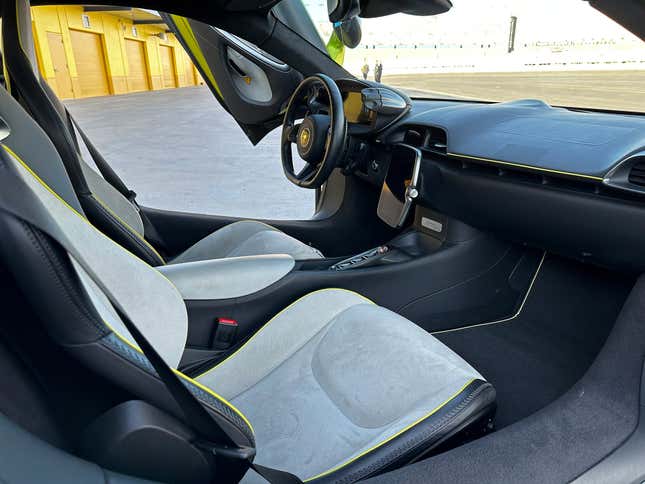
I love the new instrument cluster display that moves with the steering wheel; I also like the main infotainment screen, which resembles a big Apple Watch. Sure, the heavy bezel surrounding the display makes it look like an Android tablet from 2012, but it hovers far enough away from the dash that you can sort of hold onto the edge while thumbing the scroll knob, which is convenient.
The user interface is a cinch to navigate too; from what I understand, that’s something that couldn’t be said about McLaren’s old software. The graphics hint at an Android base — and I mean phone Android, not even Android Automotive — but it’s all responsive enough and free of frustration, just like the car. While we’re talking about software, I should also say my little road trip with my Ember Orange Artura was thankfully devoid of any of the glitches that plagued some journalists’ cars in Europe last summer, and the same was true of the track portion.
2023 McLaren Artura: The Verdict
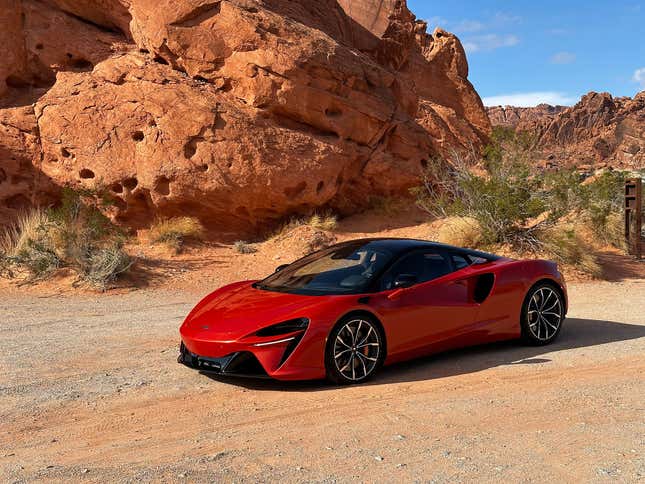
The Artura’s great, as if there was any serious doubt that it would be. And while comparisons to the 296 GTB are obvious, and there are surely a few areas in which the Ferrari might have an edge, that car also starts at almost $100,000 more than the Artura.
Electrification was supposed to be the harbinger of death for cars like these, but in the sweet spot of the small-displacement, big-torque hybrid, we get to enjoy the best of both technologies. McLaren managed something admirable here. This car had every excuse to be befuddling, frustrating, or unengaging. Instead, the McLaren Artura does it all, with grace and harmony.